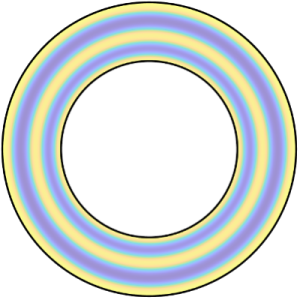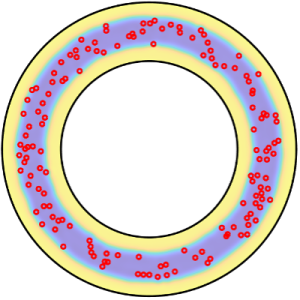By Christopher Denison (School of Mathematics & Physics)
Supervisors: Dr Marco Pinna, Dr Javier Diaz
Combining nanoparticles (particles on the scale of 10-9 m) and polymers (long-chained molecules) is promising for the future of battery technology and for interesting material properties, such as increased refractive indices and reduced flammability. The computational method chosen was Cell Dynamics Simulation (CDS), using a spherical rather than cubic boundary (we looked at cubic boundaries in previous research). In the title, “Hybrid Simulation” means to simply add nanoparticles to the polymer, using different calculations to simulate each. The need for hybrid simulation is crucial when analysing the structure of complex materials due to the vast number of calculations needed. CDS implements a balance of accuracy and speed to complete these simulations within hours rather than days (compared with other methods) whilst retaining the necessary information.


Figure 1: Simulation images of block copolymer (blue and yellow regions) with and without nanoparticles (red circles).
Throughout this project I taught myself not only the mathematical theory behind the systems we analysed, but also the computational tools. I implemented knowledge from my Differential Equations module in 2nd year and various computing modules from my undergraduate degree to write programs which would allow me to run the simulations automatically, proving incredibly useful when having to process hundreds of images. Figure 1 is an example of one of these simulation images, where the yellow region is one type of polymer and blue, another; bonding these groups of polymers forms what is called a “block copolymer”. We also looked at how its shape changed as we increased the “affinity” of the boundary (called the “boundary condition”). As this boundary condition was increased, the walls became more attracted to the yellow-type polymer.
The research skills I learned on this project were invaluable, including how to apply knowledge in areas unfamiliar to me while collaborating with academics from various research areas to understand complex maths in the systems we explored. I also learned how problem solving is often non-linear and it was important to remain open minded. There were a few cases where we reran prior simulations to determine the process behind different errors, which led us to discover new and unexpected phenomena.
One of the most valuable things about the UROS to me was being included in meetings, discussing pathways for current and future research. It was fascinating being able to apply my knowledge from the previous project to this one and involve myself in the collective thought process. I learned a lot from my supervisors, Dr Marco Pinna and Dr Javier Diaz, and having the opportunity to engage in cutting edge research spanning multiple countries and institutions was a privilege.
*To view the research poster for this project, please click on the thumbnail below:
